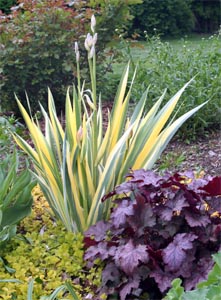
This species iris, also know as Zebra Iris, Sweet Iris, or Dalmatian Iris, is a very old garden plant. Native to rocky areas of northern Italy and the Eastern Mediterranean (including Dalmatia, a province of Croatia, hence one of the common names), it was one of the primary species used in the development of the tall bearded iris. Its dried root (along with other species of Iris) is a source of orris root powder that was used medicinally or for its supposed magical and alchemical properties in medieval times, as well as a perfume and potpourri fixative for many centuries. It may take several years of drying for the root to fully develop its fragrance. Orris oil, derived from the fresh root, is used as a flavoring in soft drinks, candies and chewing gum.

The low clumps of sword-like leaves remain nearly evergreen in mild winter climates but in cold areas the plant dies back to the ground like other irises do. The thick foliage of the cultivars commonly offered as garden plants has elegant vertical stripes of blue-green and either silvery-white (‘Alba-variegata’ or ‘Argentea Variegata’) or creamy yellow to pale gold (“Aurea-variegata’ or ‘Variegata’), depending on the cultivar. The foliage of the species is not quite as attractive, being a solid bluish-green.
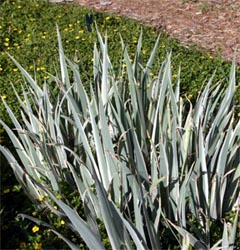
The cultivars are grown primarily for their attractive striped leaves, although they do produce pretty lavender-blue flowers with small yellow beards in early summer on 3 foot tall scapes. The tall branched stems may need staking in windy, exposed areas.
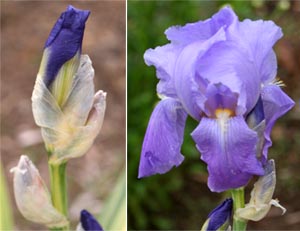
The highly fragrant flowers have a distinctive scent that is variously described as reminiscent of grape jelly, orange blossom, or vanilla.
The striking foliage of Iris pallida makes a great accent in a sunny perennial border, especially near the front. The stiff upright form offers good contrast to mounded shapes, while the dramatic coloring stands out among solid-colored foliage. It pairs nicely with traditional perennials such as fern leaf yarrow (Achillea ‘Moonshine’), purple coneflower and ‘Husker Red’ penstemon and is a good companion with Amsonia hubrechtii.
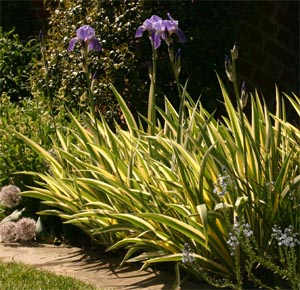
The yellow-striped varieties are especially eye-catching near purple-leaved plants. Interplant with low, open perennials or taller ramblers such as Knautia macedonica or use the plants as a neat edging in larger plantings. This iris is a natural around water and it really stands out in rock gardens. It can also be stunning in suitable containers. The gold varieties seem to be more vigorous than the white types.
Grow Iris pallida in full sun and well-drained soil for best results. Iris pallida does tolerate more shade than many bearded iris do, however. Although it prefers light sandy soils, it has thrived on my heavy clay and medium clay loam. It is hardy in zones 4-9.
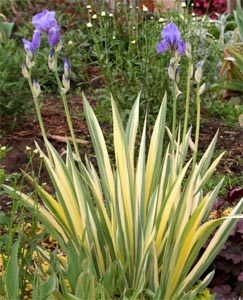
This plant requires little maintenance. Remove old foliage before new leaves emerge in early spring. Divide the clumps as necessary every 3 to 4 years after flowering, just as you would a bearded iris, although it can be done at almost any time. Place the rhizome partly above the soil and keep newly divided plants well watered. Once established, it is somewhat drought tolerant. It has few pests – rabbit and deer rarely bother it and iris borer is much less of a problem than in bearded iris.
– Susan Mahr, University of Wisconsin – Madison
Latest from Wisconsin Yard & Garden
Ask Your Gardening Question
If you’re unable to find the information you need, please submit your gardening question here:





 ▶︎ Watch: Fall Bulb Planting
▶︎ Watch: Fall Bulb Planting Aster, Symphyotrichum spp.
Aster, Symphyotrichum spp. Fascinating Fasciation
Fascinating Fasciation Alternatives to Lawn: Groundcovers
Alternatives to Lawn: Groundcovers


